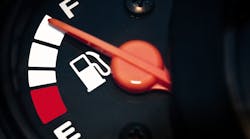The Biden administration is setting new fuel economy standards for light-duty vehicles to make them more fuel efficient—and costlier—over the next few years. The U.S. Department of Transportation announced on April 1 that it would require every OEM’s fleet of passenger cars and light trucks to average 49 mpg by model year 2026.
The new Corporate Average Fuel Economy (CAFE) standards follow one of President Biden’s first executive orders in 2021 that called on American manufacturers to lead the way on clean vehicles. The new standards will increase fuel efficiency by 8% annually for model years 2024-2025 and 10% for model year 2026. They also will increase the estimated fleetwide average by nearly 10 miles per gallon for model year 2026 relative to model year 2021.
See also: What fuel source will dominate trucking in 2030?
This National Highway Traffic Safety Administration (NHTSA) announcement comes a month after the U.S. Environmental Protection Agency (EPA) proposed new, more robust standards for heavy-duty vehicles and engines starting in model year 2027. The standards would reduce emissions of nitrogen oxides (NOx) and set updated greenhouse gas (GHG) standards for certain commercial vehicle categories.
Less than a year ago, the D.C. Circuit Court of Appeals removed trailers from an emissions regulation that had been scheduled to take effect in 2021, “Greenhouse Gas Emissions and Fuel Efficiency Standards for Medium- and Heavy-Duty Engines and Vehicles—Phase 2,” a joint effort by EPA and NHTSA also known as GHG 2.
The revisions proposed in March to existing GHG standards for heavy-duty model year 2027 and beyond would set updated GHG emissions standards for subsectors where electrification is advancing rapidly. These sectors include school buses, transit buses, commercial delivery trucks, and short-haul tractors.
In a separate action, EPA will be setting new GHG emissions standards for heavy-duty vehicles as soon as model year 2030. This action will more comprehensively address the long-term trend toward zero-emission vehicles across the heavy-duty sector, according to the agency.
New light-duty standards
According to the U.S. Department of Transportation, the light-duty vehicle rules’ increasing efficiency and reduced fuel usage would save Americans money at the pump. For example, those purchasing new vehicles in 2026 would get 33% more miles per gallon than 2021 vehicles—new car drivers in 2026 would have to fill up their tanks three times for every four times new car drivers do today.
“Today's rule means that American families will be able to drive farther before they have to fill up, saving hundreds of dollars per year,” Transportation Secretary Pete Buttigieg said. “These improvements will also make our country less vulnerable to global shifts in the price of oil, and protect communities by reducing carbon emissions by 2.5 billion metric tons.”
However, some of that fuel savings will be offset by the fuel-efficient technology OEMs will have to build into new vehicles. NHTSA projects that the rules will raise the price of a new vehicle by $1,087 in 2029. The agency projects the final standards will save consumers nearly $1,400 in total fuel expenses over the lifetimes of the more fuel-efficient vehicles.
Since CAFE became law in 1975, it has reduced American oil consumption by 25%, or about 5 million barrels a day, according to the administration. The newest CAFE standards for model year 2024-26 will reduce fuel use by more than 200 billion gallons through 2050, compared to continuing under the old standards.
“NHTSA is helping American families by making life more affordable—and the air cleaner for their children,” said Steven Cliff, NHTSA deputy administrator. “These vehicles will be better for the environment, safer than ever, and cost less to fuel over their lifetimes. We are proud to fulfill President Biden’s mission to move us to a more sustainable future, one that strengthens American energy independence and helps put more money in American families’ pockets.”
The new fuel economy standards follow President Biden’s Executive Order 13990, which directed NHTSA to review the 2020 “The Safer Affordable Fuel-Efficient (SAFE) Vehicles Rule for Model Years 2021-2026 Passenger Cars and Light Trucks” final rule.



